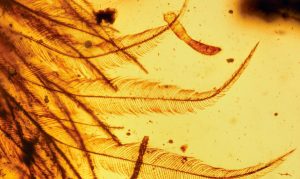There’s a remote valley in northern Myanmar where people mine dark chunks of amber that they polish and sell as jewelry at world amber markets. They’ve been collecting amber from the valley since at least the 1st century AD and the stones from here are known as “burmite”. It was only more recently that scientists dated some of the amber deposits to the Cretaceous period in earth’s history and realized its potential scientific value.
Paleontologist Lida Xing goes to the amber market regularly to hunt for pieces of amber that may contain fossils relevant to research. It was one day in 2015 when he chanced upon the first known dinosaur tail preserved in amber. And he saw that it has feathers!
The piece of amber fits into a palm and contains a bony 1.4-inch appendage covered in white and chestnut brown feathers. Scientists peg the age of the fossil at 99 million years and believe it belongs to a juvenile coelurosaur, a member of a group of theropod dinosaurs. By the time researchers got to it, the stone had already been polished and shaped for use in jewelry. The findings are published in the journal Current Biology.

As stunning as the stone looks, the preserved tail is a boon for researchers because up to now, most of what we’ve learned about dinosaur feathers come from fossilized imprints. As useful as that is for showing the feather’s arrangement and structure, they lack finer details as well as information about color.
The scientists ruled out the possibility this could be the tail of a prehistoric bird due to the structure of the vertebrae. And the shape of the feathers indicate they were probably not used for flight.
“The open, flexible structure of the feathers is more similar to modern ornamental feathers than to flight feathers, which have well-defined central shafts, branches, sub-branches, and hooks that latch the structure together,” writes Kristin Romey for National Geographic. If the rest of the tail was covered in the same kind of feathers as this sample, the dinosaur was most likely a ground-dweller.

Scientists are calling the amber sample Eva in honor of paleobotanist Eva Koppelhus, the wife of co-author Philip Currie. It’s previous name is DIP-V-15103. It was originally mined out of Hukawng Valley in Kachin state, which houses some of the most biodiverse amber deposits in the world. In addition to the feathered tail, Xing also found a pair of preserved dinosaur wings in a piece of amber taken out of Hukawng Valley.
And dinosaurs aren’t the only specimens scientists are discovering in the amber. In 2006, George Poinar, Jr. of Oregon State University found the earliest known species of bee in another piece of amber originating from this valley. The prehistoric bee shares features of both bees and wasps and supports the theory that pollen-eating bees originally evolved from meat-eating wasps.











